![]()
![]()
![]()
Use LEFT and RIGHT arrow keys to navigate between flashcards;
Use UP and DOWN arrow keys to flip the card;
H to show hint;
A reads text to speech;
28 Cards in this Set
- Front
- Back
|
Marketing orientation
|
A marketing-oriented organisation devotes resources to understanding the needs and buying behaviour of customers, competitors’ activities and strategies, and of market trends and external forces – now and as they may shape up in the future; interfunctional coordination ensures that the organisation’s activities and capabilities are aligned to this marketing intelligence
|
|
|
Marketing defined
|
Individual and organisational activities that facilitate and expedite satisfying exchange relationships in a dynamic environment through the creation, distribution, promotion and pricing of goods, services and ideas
|
|
|
Marketing concept
|
The market concept holds that the key to achieving organisational goals businesses must satisfy customers' needs and wants in order to make a profit
|
|
|
basic priorities of marketing
|
• satisfying customers
• endeavouring to beat and pre-empt competitors • identifying/maximising marketing opportunities • utilising resources/assets effectively • targeting the ‘right’ customers • increasing market share • facilitating exchange relationships • enhancing profitability or income • staying ahead in dynamic environment • satisfying the organisation’s stakeholders. |
|
|
Customers vs Consumers
|
those who buy a product vs those who use the product
ex: (cinnamon toast crunch) cereal = mom vs child |
|
|
Marketing Mix
|
The elements of the marketing mix are known as variables because marketers can manipulate them in order to achieve their marketing objectives.
The variables are commonly referred to as the 5 P's: product, place, Promotion, price, & people |
|
|
Product
|
The aspect of the marketing mix that deals with researching consumers' product wants and designing a product with the desired characteristics
Activities: Develop and test-market new products; modify existing products; eliminate products that do not satisfy customers’ desires; formulate brand names and branding policies; create product guarantees and establish procedures for fulfilling guarantees; plan packages, including materials, sizes, shapes, colours and designs |
|
|
Place/distribution
|
The aspect of the marketing mix that deals with making products available in the quantities desired to as many customers as possible and keeping the total inventory, transport and storage costs as low as possible
Activities: Analyse various types of distribution channels; design appropriate distribution channels; select appropriate channel members and partners; design an effective programme for dealer relations; establish distribution centres; formulate and implement procedures for efficient product handling; set up inventory controls; analyse transportation methods; minimise total distribution costs; analyse possible locations for plants and wholesale or retail outlets |
|
|
Promotion (marketing communications)
|
The aspect of the marketing mix that relates to activities used to inform one or more groups of people about an organisation and its products
Activities: Set promotional objectives; determine major types of promotion to be used; select and schedule advertising media; develop advertising messages; measure the effectiveness of advertisements; recruit and train salespeople; formulate payment programmes for sales personnel; establish sales territories; plan and implement sales promotion efforts such as free samples, coupons, displays, competitions, sales contests and cooperative advertising programmes; prepare and disseminate publicity releases; evaluate sponsorships; provide direct mail; and establish websites or Internet facilities |
|
|
Price
|
The aspect of the marketing mix that relates to establishing pricing policies and determining product prices
Activities: Analyse competitors’ prices; formulate pricing policies; determine method(s) used to set prices; set prices; determine discounts for various types of buyer; establish conditions and terms of sales; determine credit and payment terms; understand the consumers’ notion of value |
|
|
People
|
The aspect of the marketing mix that reflects the level of customer service, advice, sales support and after-sales back-up required, involving recruitment policies, training, retention and motivation of key personnel
Activities: Manipulate the marketing mix and establish service levels, guarantees, warranties, expertise, sales support, after sales back-up, customer handling requirements, personnel skills training and motivation (people as marketers); make products and services available (people as intermediaries); provide a market for products (people as consumers) |
|
|
Exchange
|
The provision or transfer of goods, services and ideas in return for something of value.
For an exchange to take place, four conditions must exist: 1 Two or more individuals, groups or organisations must participate. 2 Each party must possess something of value that the other party desires. 3 Each party must be willing to give up its ‘something of value’ to receive the ‘something of value’ held by the other party. The objective of a marketing exchange is to receive something that is desired more than that which is given up to get it – that is, a reward in excess of costs. 4 The parties to the exchange must be able to communicate with each other to make their ‘something of value’ available. |
|
|
What is meant by Product?
|
Product
is viewed as being a good, a service or an idea. A good is a physical entity that can be touched. A Ford Focus, a Sony compact disc player, Kellogg’s Cornflakes, a bar of Lux soap and a kitten in a pet shop are examples of goods. A service is the application of human and mechanical efforts to people or objects in order to provide intangible benefits to customers. Services such as air travel, dry cleaning, hairdressing, banking, medical care and childcare are just as real as goods, but an individual cannot actually touch or stockpile them. Marketing is utilised for services but requires certain enhancements in order to be effective (see Part III). Ideas include concepts, philosophies, images and issues. For instance, a marriage counsellor gives couples ideas and advice to help improve their relationships. Other marketers of ideas include political parties, charities, religious groups, schools and marketing lecturers. |
|
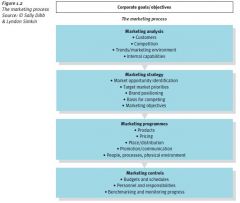
Marketing process
|
Analysis of market conditions, creation of an
appropriate marketing strategy, the development of marketing programmes designed to action the agreed strategy, and finally the management and control of the marketing programmes using budgets and benchmarking etc.. |
|
|
What is 'marketing strategy'?
|
It involves "selecting opportunities to pursue,
analysing a target market...developing a competitive advantage and creating and maintaining an appropriate marketing mix...that will satisfy those customers in the target market." |
|
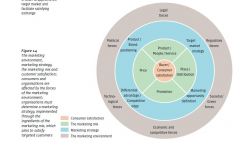
Marketing strategy stages
|
1). Marketing strategy starts by appraising existing and emerging opportunities.
2). The firm then devises a target market strategy involving segmenting (grouping the market's customers in different categories), targeting (selecting customers from among these segments), developing a basis for competing and agreeing an appropriate brand positioning. 3). Finally the firm configures a suitable marketing mix which will deliver the basis for competing and brand positioning to the selected target market. (The elements of the marketing mix are called marketing mix 'variables' because marketers can manipulate them in order to achieve their marketing objectives. They are the 4Ps, product, place, price, promotion, plus a fifth component called 'people' for services marketers. Manipulating the marketing mix will involve (a). having a suitable combination of product characteristics (b). choosing appropriate distribution strategies (c). varying prices and (d). varying promotion strategies to suit the market in which the product is being sold). |
|
|
Marketing opportunity
|
One that exists when circumstances allow an organisation to take action towards reaching a particular group of consumer or business customers
|
|
|
Marketing management
|
A process of planning, organising, implementing and controlling marketing activities to facilitate and expedite exchanges effectively and efficiently
|
|
|
Why should an organisation develop a marketing strategy?
|
Marketing strategy is defined as a ‘strategy indicating the opportunities to pursue, specific target markets to address, and the types of competitive advantages that are to be developed and exploited’ (Dibb and Simkin, p. 37).
The reasons why an organisation should develop a marketing strategy are: The strategy will ensure that there are benefits to the organisation (as well as to the targeted customers) from selling its products or services. The strategy will enable the organisation to focus on opportunities that it wishes to pursue and on specific objectives. |
|
|
What is the difference between strategic market planning and the strategy itself?
|
A strategic market plan is not the same as a marketing plan". A strategic market plan is a plan of all aspects of an organisation's strategy in the marketplace. A
marketing plan, in contrast, deals primarily with implementing the marketing strategy – it states which are the priority target markets and details the marketing programmes (particularly, marketing mix variables) for those markets. |
|
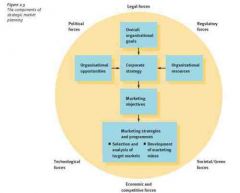
Identify the major components of strategic market planning and explain how they are interrelated.
|
The components of strategic market planning are shown in Figure 2.3 in Dibb and Simkin. As shown in the diagram, the organisation’s goals have to be established and need to take into account various environmental forces, such as economic, societal/green, legal and technological factors. These forces then influence subsequent areas of decision making. Organisational goals drive corporate strategy, which must take organisational opportunities and resources into consideration. Corporate strategy helps to determine marketing objectives which, in turn, drive the marketing strategies and programmes that the organisation pursues.
|
|
|
Why is marketing opportunity analysis necessary?
|
Marketing opportunity analysis is a way for an
organisation to ascertain if there is a 'fit' between its capabilities and the external environment". Opportunity analysis can lead to the organisation being able to develop a differential advantage and hence a competitive advantage. |
|
|
What are the determinants of marketing opportunity?
|
The determinants of marketing opportunity are the combination of circumstances (in the marketing environment) arising at such a time that an organisation can take advantage of them. Sometimes the circumstances may be suitable but the time may not be right for the organisation. This might be because the firm does not have a product ready to release to the market. Circumstances are therefore determined by the external environment (outside the organisation), whereas timing is related to the internal environment and the firm’s ability to take advantage of the circumstances.
|
|
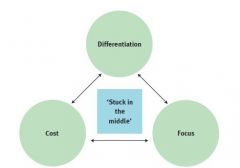
Difference between differential advantage (= competitive edge) and competitive advantage
|
Porter says there are three generic routes to competitive advantage:
differentiation (e.g. novel product designs, novel distribution channels), cost leadership: (developing a low cost base) and focus (product and marketing effort are designed with a particular target group in mind). Differential advantage builds on the first of these. It distinguishes a company's product/service from that of competitors due to a perceived functional difference that is unique to just one supplying organisation. A lot of organisations or brands do not have a differential advantage. Competitive advantage refers to when an organisation outperforms its competitors or undercuts them in terms of price. "...any aspect of the marketing mix, basis for competing or brand positioning may deliver a differential advantage, and thereby provide the potential for a successful competitive advantage". |
|
|
What is environmental scanning and environmental analysis?
|
environmental scanning as ‘the process of collecting information about the forces in the marketing environment.
Environmental analysis refers to ‘the process of assessing and interpreting the information gathered through environmental scanning’ |
|
|
Why are environmental scanning and environmental analysis so important?
|
environmental Scanning is important because organisations need to be aware of developments that may be taking place in the environment in which they are competing. When a firm is out of touch with these changes, it may not be ready to take advantage of new opportunities, leaving them open to competitors, or it may be unaware of impending threats that may harm the business.
Collecting information about the environment needs to be followed by careful assessment and analysis of the data. This environmental analysis ensures that the data is correctly interpreted. For example, consumer expenditure on a firm’s goods may be rising. By also analysing how much is being spent with competitors, it is possible to assess whether or not future market share is likely to be maintained. |
|
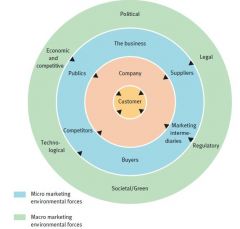
forces of the Macro and Macro Environement
|
The marketing environment consists of external forces that directly or indirectly influence an organisation’s acquisition of inputs and generation of outputs. Inputs might include personnel, financial resources, raw materials and information. Outputs could be information such as advertisements or packages, goods, services and ideas. As shown in Fig, the broad marketing environment consists of six categories of forces: political, legal, regulatory, societal/Green, technological and economic/competitive. Although there are numerous environmental factors, most fall into one of these six categories. These are termed the ‘macro forces’ of the marketing environment as they affect all organisations operating in a particular market. In addition, many authors have identified a set of issues termed the ‘micro forces’ of the marketing environment. These micro forces are more situation- and organisation-specific, including the organisation’s internal environment, suppliers, marketing intermediaries, buyers, competitors and the organisation’s publics.
|
|
|
What is SWOT Analysis
|
SWOT analysis is the examination of an organisation’s strengths and weaknesses, opportunities and threats, usually depicted on a four-cell chart
|

